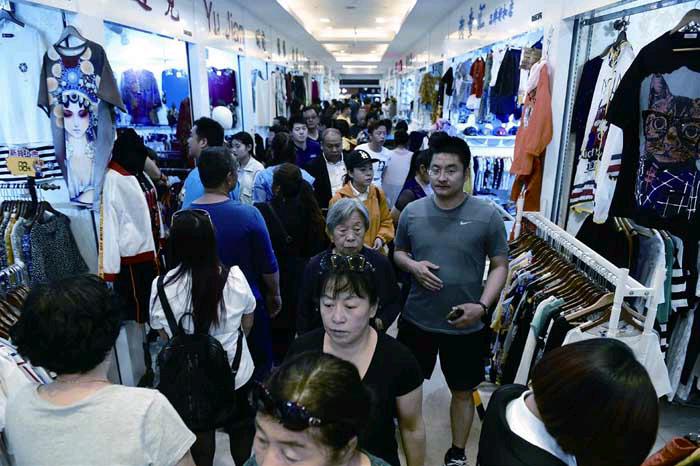Experiencing History
2017-06-08
Children learn woodblock printing at a tourism promotion activity in the ancient town of Nanxun, Huzhou, east Chinas Zhejiang Province, on May 13.
Paid Annual Leave
About 73.5 percent of surveyed people said that they received paid annual leave, while 21.9 percent of people said they did not.
The survey, conducted among 1,997 employees, was published in China Youth Daily on May 16.
According to a regulation on paid annual leave, which was made effective in 2008, employees who work consecutively for more than one year should receive paid days off.
In the survey, 64.9 percent of correspondents said that their employers asked them to use their paid annual leave within a year, and if they did not, their paid vacation would expire.
Wen Chenjing, a member of the labor relations research committee of the Shanghai Bar Association, said that there is no legal basis to reset paid annual leave after a year.
National legal annual leave can be spent after a year, while extra vacation allowed by employers could expire in accordance with company regulations, said Wen.
In response to a question about how to implement the regulation on paid annual leave, 42.2 percent of surveyed people wished to increase supervision and punish violators, and 20.7 percent of people wished to improve laws and regulations.
Ransomware Attack
Chinas cyberspace authority on May 15 warned computer users to install and upgrade computer security software to avoid ransomware attacks.
Police and various government authorities have taken counter measures against a global ransomware attack, and Internet security companies, including Qihoo 360, Tencent and Kingsoft Security, have also acted to provide increased security services, according to a statement issued by the cybersecurity coordination bureau of the Cyberspace Administration of China.
The spread of the ransomware is slowing down, the statement said.
About 18,000 IP addresses in China have been confi rmed as infected with the “WannaCry”ransomware, which began to spread worldwide on May 12, according to the National Computer Network Emergency Response Technical Team/Coordination Center(CNCERT).
Another 5,471 IP addresses, mostly in Beijing, Shanghai and coastal provinces such as Guangdong and Zhejiang, are likely to have been infected by the computer virus, according to the center.
“Intranets in many industries and enterprises involving banking, education, electricity, energy, healthcare and transportation have been affected to different extents,” it said.
The ransomware has paralyzed the online payment systems at some petrol stations across China since May 12, and also invaded some colleges, encrypting papers and other documents.
Once a computer is infected by the ransomware, almost all documents and programs will be encrypted and users will be asked to pay to remove the virus, said Han Zhihui, a computer engineer at CNCERT.
Currently, the cybersecurity industry is not aware of an effective means of decryption, Han said.
He said users could re-install the operating system on infected computers, but run the risk of losing important data and documents.
The cyberspace authority said this global cyberattack has once again shown the unprecedented Internet security challenges, calling on all sectors to address cybersecurity issues.
Harassment on Campus
More than 7 percent of university students surveyed said that they have experienced harassment from unidentifi ed people on their college campuses.
The survey, which polled 601 students from over 100 Chinese universities, revealed that 7.58 percent of the respondents had experienced harassment, according to an article in China Youth Daily on May 15.
Moreover, about 65.24 percent said they had heard of similar situations experienced by their classmates.
However, the article quoted some students as saying that in many cases victims did not dare to directly confront the harassers and many felt too ashamed to tell their families or teachers.
Students surveyed also said that enhanced security is required on university campuses. A total of 58.81 percent of the students said their campuses allow members of the public to enter freely, while 81.38 percent said universities should take measures to control entry.
Family Doctor Services
Twenty seven provinces, autonomous regions and municipalities across China have issued guidelines or plans for promoting family doctor services, according to the top health authority.
By the end of 2016, 22.2 percent of Chinese citizens and 38.8 percent of priority groups enjoyed services from family doctors in cities that piloted the program, the National Health and Family Planning Commission announced recently.
Priority groups are seniors, pregnant women, children, the disabled, patients with chronic diseases such as hypertension, diabetes and tuberculosis, as well as those with severe mental disorders.
Family doctor services will be extended to over 85 percent of Chinese cities, covering 30 percent of the urban population and over 60 percent of priority groups in 2017, said Li Bin, head of the commission.
The program is key to establishing a tiered disease treatment system, which means medical institutions receive patients according to the severity of their illnesses, said Li.
To attract more family doctors, the government will also facilitate the transfer of patients with more advanced conditions to major hospitals, according to an offi cial with the commission.
Family doctors, including general practitioners registered with grassroots health institutions, qualifi ed doctors at township clinics and village doctors, provide basic medical care and other health services.
Curing Tools
People attend the China International Medical Equipment Fair in Shanghai on May 15. The fair, which opened the same day, attracted more than 4,000 companies from home and abroad.
Public Hospital Reform
China will expand reform in public hospitals nationwide in 2017, the National Health and Family Planning Commission (NHFPC) announced on May 11.
The hierarchical medical system pilot program will also be expanded to reach at least 85 percent of prefecturelevel regions, according to documents released by the commission.
More policies will be issued regarding the hierarchical medical system, hospital management, medical insurance, medicine supplies and comprehensive supervision by the end of 2017.
Liang Wannian, an NHFPC offi cial, said that system reforms covering medical services, insurance and medicine should be advanced in a coordinated manner.
China has earmarked over 1.4 trillion yuan ($203 billion) in its budget for health and medical expenditure in 2017.
New Opportunities
Consumers are seen in Dongmao International Clothing Market in Yanjiao of Sanhe, north Chinas Hebei Province, on May 14. The clothing market started trial operation that day. Since the second half of 2016, about 1,500 shop owners from the renowned Beijing Zoo Wholesale Market and Dahongmen Clothing Wholesale Market have been relocated to the new site in Yanjiao.
Foreign Relics
The Beijing-based Palace Museum on May 13 opened a new branch to exhibit foreign antiques on the resort island of Gulangyu in east Chinas Fujian Province.
The 219 foreign items on display, largely accessible to the public for the fi rst time, feature china from Europe and Japan, snuff boxes imported from the West, fabric, furniture, and scientifi c instruments used in the imperial palace.
The Palace Museum has collected a large number of foreign cultural relics, including paintings, lacquerware, ceramics, timepieces and scientifi c instruments, but those on display account for less than 6 percent of the total amount, said museum curator Shan Jixiang, adding that most of the items are stored in warehouses.
The foreign relics will be gradually moved to the new museum, which covers over 10,000 square meters.
“They are proof of the rich cultural exchanges between China and other countries over the centuries,”he added.
Financing Support
A three-year work program (2017-19) on aid for small businesses was unveiled on May 16.
“Receivable accounts are important liquid assets for small and micro-sized businesses,” said the program, drawn up by the Peoples Bank of China (PBOC), Ministry of Industry and Information Technology, Ministry of Commerce, State-Owned Assets Supervision and Administration Commission of the State Council, China Banking Regulatory Commission and State Administration of Foreign Exchange.
The PBOC started an online receivable fi nancing platform for small businesses on December 31, 2013.
By the end of March, a total of 1.6 trillion yuan ($233 billion) of fi -nancing had been generated by the platform, accounting for 35 percent of the total fi nancing of small and micro-sized businesses.
According to the program, training courses and intensifi ed policy support for receivable fi nancing will be provided.
Small enterprises are very important for job creation in China.
Trial Run
A bullet train arrives at a station in Baoji, Shaanxi Province, on May 16, marking the launch of a comprehensive test of the newly-built high-speed railway line linking Baoji and Lanzhou, Gansu Province.
The 401-km line, which will improve transport between the two cities with trains running at a speed of up to 250 km per hour, is set to be operational within the year.
Retail Sales Up
Chinas retail sales, a key indicator of consumption, grew 10.7 percent year on year in April, 0.2 percentage points slower than the March level, offi cial data showed on May 15.
Total retail sales of consumer goods hit 2.73 trillion yuan ($395.4 billion) in April, according to the National Bureau of Statistics (NBS). It increased 0.79 percent month on month.
In the fi rst four months of this year, total retail sales of consumer goods rose 10.2 percent year on year, 0.2 percentage points faster than the growth in the fi rst quarter, according to Xing Zhihong, an NBS spokesman.
Consumption activities were relatively stronger in rural areas, with retail sales expanding 12.6 percent in April, outpacing urban areas, where retail sales climbed 10.4 percent year on year.
Online spending was robust. From January to April, online retail sales surged 32 percent year on year to 1.92 trillion yuan ($278.8 billion).
Xing said the April fi gure indicates continued expansion of domestic consumer demand, which was partly driven by consumption upgrades and new business patterns such as online sales.
China is trying to shift its economy toward a growth model driven by consumer spending, innovation and services, while weaning it off reliance on exports and investment.
Chinas economy expanded at a 6.9-percent pace in the fi rst quarter, accelerating from 6.8 percent in the previous quarter, and 77.2 percent of it was driven by consumption, 12.6 percentage points higher than the 2016 level, according to offi cial data.
Bond Connect
A bond connect program between the mainland and Hong Kong markets was approved on May 16 in the latest effort to support the fi nancial hub and accelerate the countrys opening up progress.
Investors on both sides will be able to trade bonds on each others markets, according to a joint statement from the Peoples Bank of China and the Hong Kong Monetary Authority. Northbound trade will be launched fi rst, without caps on investment volume.
The program marked another major move from the central government to support Hong Kongs development and grant overseas capital wider access to the mainlands fi nancial sector.
The launch date remains subject to further notice.
Risk Control
Chinas banking regulator said on May 15 it would bring in new legislation this year to plug regulatory loopholes and step up supervision to guard against fi nancial risks.
Law-making will strengthen key fi elds including shareholding entrustment, fund supervision and fi nancial services, according to the China Banking Regulatory Commission.
Legislation should pay more attention to ensuring there will be no systemic fi nancial risk.
The commission plans to complete 46 legislative programs in 2017, covering risk management on bankruptcy and liquidity of commercial banks as well as on cross products services.
Research will be made on another 16 programs including microf niance company supervision and trust company liquidity management, according to the commissions work plan.
Mega Show
Staff workers at a big data demonstration center at Guizhou Shuanglong Airport Economic Zone in Guiyang, Guizhou Province, on May 16.
The 2017 China International Big Data Industry Expo, the fi rst of its kind in the world, will be held in Guiyang from May 25 to 28. It will focus on the exploration and application of big data and display the latest technological innovations and achievements in the industry.
Fintech Committee
The Peoples Bank of China (PBOC), the countrys central bank, announced on May 15 that it has set up a fi ntech committee to enhance research, planning and coordination of work on fi nancial technology.
In order to make strategic plans and provide policy guidance on fi ntech development, the PBOC said it will further study its infl uence on monetary policy, fi nancial markets, fi nancial stability, payment and clearing.
“Fintech, or technologydriven fi nancial innovation, has both injected vitality into fi nancial development and brought new challenges to fi nancial security,”said the bank in a statement on its website.
The central bank will devise a management mechanism for fi ntech innovation to handle relations between security and development and guide the proper use of new technology in the fi nancial fi eld.
The PBOC will also increase the use of regulatory technology, or “regtech,” to boost its capabilities in identifying, preventing and dissolving fi nancial risks, including both cross-sector and cross-market risks, with technology such as big data, artifi cial intelligence and cloud computing.
Private Bank
The fi rst private bank in northeast China went into operation on May 16.
Headquartered in Jilin, one of the three northeastern provinces, Yillion Bank was approved in December 2016 by the China Banking Regulatory Commission.
The lender is mainly for personal consumers and will provide fi nancial support to small and microsized fi rms.
“The bank is expected to promote the development of the local private economy and plays a positive role in rejuvenating the regions economy,” said Miao Zhongyou, Deputy Director of the Jilin Provincial Finance Offi ce.
Over the past two years, the economy of northeast China, which also includes Heilongjiang and Liaoning provinces, has grown more slowly than the rest of the country. In 2014, China approved a pilot scheme to set up fi ve private banks to give private capital a bigger role in the countrys fi nancial system. Nationwide, the number of private banks has reached 17, with nine of them currently operational.
Industrial Cooperation
Workers operate machines to produce aluminum rods at a factory in an industrial park in Zouping County, Shandong Province.
The industrial park, which is home to seven high-end aluminum producers, is part of an aluminum processing alliance composed of companies from China, Singapore and Guinea.
CHAPS Stakeholder
Bank of China (BOC) has joined CHAPS Clearing Co. Ltd., Britains electronic same-day payment system, as a shareholder and direct participant with immediate effect.
BOC is the fi rst Asianheadquartered direct participant in the Clearing House Automated Payment System (CHAPS), which brings the total number of the systems direct participants to 25.
Sun Yu, General Manager of BOCs London branch, said, “After joining CHAPS, we have completed another vital step towards the internationalization of our direct clearing network, now covering the worlds major currencies. Our customers will benefi t from the more effi cient, secure and fl exible payment and settlement services provided by BOC.”
Tim Fitzpatrick, chief executive of CHAPS Co., said, “BOC is a leader in banking and fi nancial services with an international presence in over 50 countries, and their participation in CHAPS further extends the accessibility of our service around the globe.”
New-Energy Cars
General Motors Co. (GM) plans to launch 10 new-energy vehicles including hybrid electrics, plug-in hybrids and pure electrics in China by 2020.
Besides the Cadillac CT6 plugin hybrid electric that is already on sale in China, GMs Buick will have a pure battery-electric for China by 2020.
New-energy vehicles are the focus of U.S. automakers. Months ago, GM launched its new 2017 Chevrolet Bolt EV. Recently, the Buick Velite 5 plug-in hybrid electric vehicle has made its debut.
Available at a price of around$30,000 after federal income tax credit, GM sold 4,384 Bolt EVs in April in the United States.
A McKinsey & Co. study in January found the cost of an average battery pack has dropped from more than $1,000 per kilowatt hour to an estimated $227 per kilowatt hour in 2016. The research fi rm predicts that the cost could fall to less than $190 per kilowatt hour by the end of 2020.
